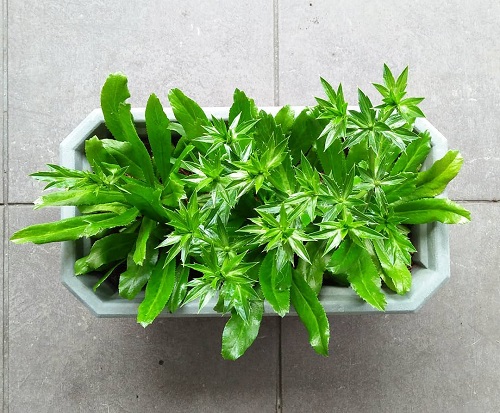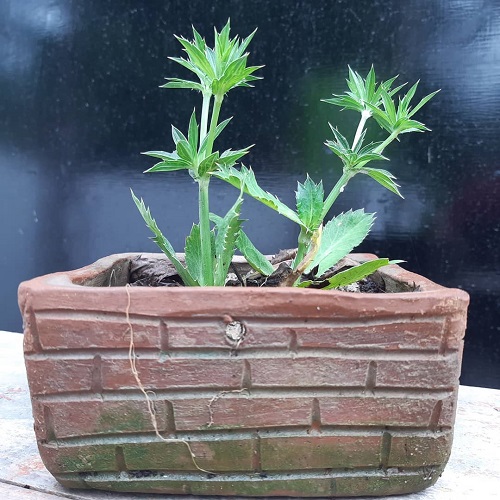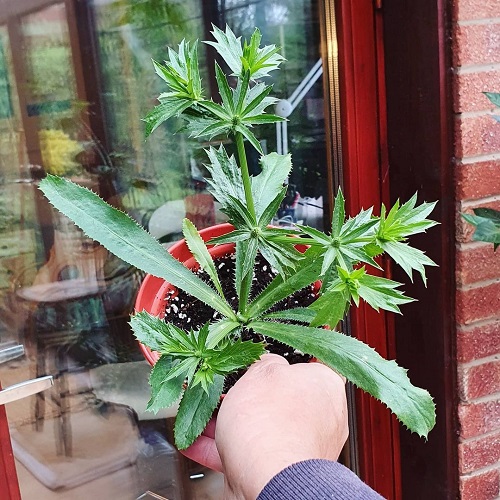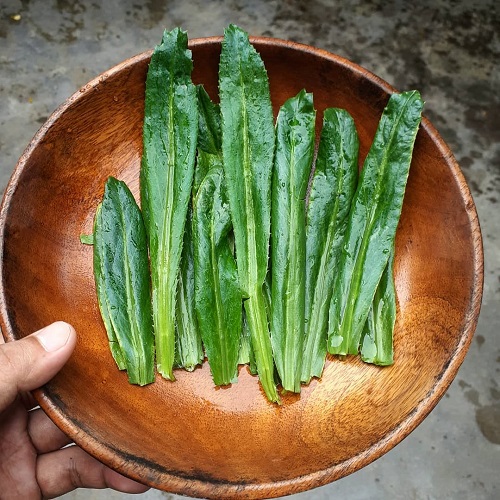Growing Culantro is a wonderful way to enjoy its unique flavor and aroma in your culinary creations. Here are the details!

Unlock the secrets of growing the aromatic herb, Culantro, with this comprehensive “Everything About Growing Culantro” guide. Learn about the ideal growing conditions, and expert tips for harvesting!
Botanical Name: Eryngium foetidum
USDA Zones: 7-11
Common Names: Sawroot coriander, Serrated coriander, Recao, Chardon benee, Shado beni, Fitweed, Coulante, and Bhandhania.
What is Culantro

Culantro, scientifically known as Eryngium foetidum, is a popular herb commonly used in various cuisines around the world. Often mistaken for cilantro due to its similar appearance, culantro has a distinct flavor profile that sets it apart.
Culantro is native to Central and South America, as well as the Caribbean, and thrives in tropical and subtropical regions. It is a biennial herb that typically grows up to two feet tall, with long, serrated leaves that resemble parsley or cilantro. The leaves of the culantro plant are known for their intense aroma and pungent taste, making them a sought-after ingredient in many dishes.
The leaves have both culinary and medicinal uses. With its unique flavor and versatility, culantro adds a distinct taste to dishes like soups, stews, curries, salsas, and marinades. It is particularly popular in Latin American, Caribbean, and Southeast Asian cuisines.
How to Grow Culantro
From Seeds
- Choose a suitable location with warm and humid conditions and ample sunlight.
- Prepare the soil by ensuring it is well-drained, loose, and rich in organic matter.
- Sow culantro seeds directly into the soil or start them in seedling trays, planting them at a depth of around ¼ inch and spacing them 2-3 inches apart.
- Provide consistent moisture by watering the plants regularly, keeping the soil moist but not waterlogged.
- Thin out the seedlings once they reach a height of around 4 inches to allow sufficient space for growth.
- Apply a balanced fertilizer every four to six weeks to promote healthy foliage and overall growth.
- Harvest culantro leaves when they reach their maximum size, typically around 10 to 12 inches in length, by cutting the outer leaves from the base of the plant.
Find How Vinegar Improves Seed Germination (Proven by Science) here
From Cuttings
- Choose mature, healthy culantro plants with vibrant leaves and strong stems for taking cuttings.
- Using clean and sharp gardening shears or scissors, cut 4 to 6 inches (10 to 15 cm) stems from the parent culantro plant. Make sure each cutting has at least a couple of leaf sets.
- Trim off the lower set of leaves from the cutting, leaving a clean stem.
- If desired, dip the cut end of the culantro cutting in a rooting hormone powder or gel to promote root development.
- Fill small pots or containers with well-draining potting soil or a mixture of perlite and peat moss. Make a small hole in the soil and insert the cut end of the culantro cutting, gently pressing the soil around it for support.
- Place the pots in a location that receives bright, indirect sunlight. Ensure the temperature is consistently warm, ideally around 70-85°F (21-29°C).
- Keep the soil evenly moist but not waterlogged. Avoid overwatering to prevent rotting of the cutting.
- To retain moisture and create a humid environment, cover the pots with a clear plastic bag or use a small greenhouse. This will help the cuttings establish roots.
- Mist the culantro cuttings regularly with water to maintain humidity and prevent the leaves from drying out.
- After a few weeks, check for signs of root development by gently tugging the cutting. If you feel resistance, it indicates that roots have formed.
- Once the culantro cuttings have developed a healthy root system, transplant them into larger pots or directly into a well-prepared garden bed, spacing them about 6 to 12 inches (15 to 30 cm) apart.
Plant Pot Size for Growing Culantro
When it comes to choosing the right pot size for growing culantro, it’s important to provide enough space for the herb’s root system to develop and expand.
A pot that is at least 8 to 10 inches deep and has a diameter of around 12 to 14 inches is generally suitable for cultivating culantro. This size allows the herb’s roots to spread comfortably and ensures sufficient soil volume for nutrient absorption and water retention.
Here are Plant Pot Sizes from Inches to Gallon
Requirements for Growing Culantro

Sunlight
Culantro thrives in full sunlight to partial shade conditions. It prefers a minimum of 4-6 hours of direct sunlight per day. However, in extremely hot climates, providing some shade during the hottest part of the day can help prevent the herb from wilting or drying out.
Soil
Culantro prefers well-drained soil that is rich in organic matter. It grows best in soil with a slightly acidic to neutral pH ranging from 6.0 to 7.0.
Learn How to Check the Soil pH at Home here
Amending the soil with compost or well-rotted manure before planting can improve its fertility and moisture-retention capacity, ensuring optimal growth for the culantro plants.
Water
Adequate watering is crucial for culantro plants. They require consistent moisture to thrive, but it is essential to avoid overwatering, which can lead to root rot. Keep the soil evenly moist by watering the plants regularly, especially during dry periods.
The frequency of watering may vary depending on factors such as temperature and humidity levels, so it’s important to monitor the soil moisture and adjust the watering schedule accordingly.
Here are the best ways to water plants
Temperature & Humidity
Culantro is a tropical herb that prefers warm temperatures and high humidity. It thrives in temperatures ranging from 70 to 85°F (21 to 29°C). In regions with cooler climates, it is best to grow culantro during the warmer months or provide protection from cold temperatures.
Additionally, culantro appreciates high humidity levels, so if you live in a dry climate, misting the leaves with water or using a humidifier can help create a more favorable growing environment for the herb.
Here are 10 Ways To Increase Humidity For Houseplants That Work
Culantro Care

Fertilizer
Culantro plants benefit from regular feeding with a balanced fertilizer to ensure healthy growth and robust foliage. Use a slow-release granular fertilizer or a liquid fertilizer formulated for herbs or vegetables.
Avoid over-fertilizing, as it can lead to excessive leaf growth at the expense of flavor.
Here are Effective Homemade Lawn Fertilizers That Are Safe From Hazardous Chemicals
Pruning
Pruning culantro is not typically necessary, as the plant tends to focus its energy on producing leaves for culinary use. However, if the plant becomes too leggy or starts flowering, you can trim it back to encourage bushier growth and prevent it from going to seed.
Regularly harvesting the outer leaves also helps promote continuous leaf production. Simply use clean garden shears or scissors to trim the desired amount of foliage, leaving the inner leaves intact for future growth.
Pests and Diseases
While culantro is generally resistant to many pests and diseases, it may still encounter some common issues. Aphids, caterpillars, and slugs can occasionally be problematic. Monitor the plants regularly and employ organic pest control methods, such as hand-picking or using insecticidal soap or neem oil if necessary.
Proper spacing and good airflow can help reduce the risk of fungal diseases like leaf spots or powdery mildew. If any signs of disease appear, promptly remove infected leaves and treat the plants with appropriate organic fungicides as recommended.
Click here to learn the Amazing Natural Pesticide Recipe that can Kill any Pest
Culantro Benefits

- Reduces Cholesterol Levels: Culantro contains compounds that can help lower LDL (bad) cholesterol levels while increasing HDL (good) cholesterol levels, promoting a healthier lipid profile.
- Lowers Blood Pressure: Certain components in culantro may act as natural diuretics, helping to reduce blood volume and subsequently lower blood pressure, potentially benefiting individuals with hypertension.
- Antioxidant Activity: The antioxidants found in culantro can help protect against oxidative stress and inflammation, both of which contribute to cardiovascular diseases.
- Enhances Digestion: The fiber content in culantro can promote regular bowel movements, prevent constipation, and support overall digestive health.
- Antimicrobial Properties: Culantro contains compounds that exhibit antibacterial and antifungal properties, which may help combat harmful microorganisms in the digestive system.
Here are the 11 Low Maintenance Houseplants With Health Benefits
Frequently Asked Questions
1. Cilantro vs. Cuantro: Difference between Cilantro and Culantro
Cilantro and culantro are two distinct herbs often confused due to their similar names and appearances, but they have notable differences in taste, appearance, and culinary uses.
Cilantro, also known as coriander leaves or Chinese parsley, has delicate, feathery leaves and a citrusy, slightly sweet flavor. It is commonly used in Mexican, Indian, and Asian cuisines as a garnish or ingredient in salsas, salads, and curries. On the other hand, culantro, also called Mexican coriander or long coriander, has long, serrated leaves with a stronger flavor reminiscent of cilantro but with a slightly more intense and pungent taste.
2. Can You Grow Culantro Indoors?
Yes, you can successfully grow culantro indoors as it adapts well to container gardening. Provide it with sufficient light, warmth, and moisture to ensure its growth and flavor development.
3. Does Culantro Taste Like Cilantro?
Culantro has a similar taste to cilantro, but it is more intense and pungent. While they share some flavor characteristics, culantro’s taste is often described as stronger and with a hint of citrus.
4. How Long Does Culantro Take to Grow?
Culantro typically takes around 8 to 12 weeks to reach maturity from seed. However, it is important to note that culantro can be slow to germinate, so it may take a couple of weeks for the seeds to sprout. Patience and proper care are key during the growing process.


